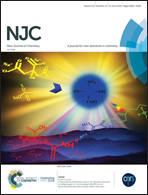Fabrication of carbohydrate microarrays on poly(2-hydroxyethyl methacrylate)-cyanuric chloride-modified substrates for the analysis of carbohydrate–lectin interactions†
Abstract
Carbohydrate microarrays provide a powerful tool for high-throughput analysis of carbohydrate-mediated interactions. In this work, they were fabricated on poly(2-hydroxyethyl methacrylate) (pHEMA)-cyanuric chloride (CC)-modified substrates for the analysis of carbohydrate–lectin interactions. The pHEMA polymer provides an anti-fouling surface and the CC linker allows the covalent immobilization of intact carbohydrates. Carbohydrates of different sizes (mannose, glucose, galactose, maltose, and dextran) were successfully immobilized on the proposed substrates and their recognition specificity with concanavalin A (ConA) was highly conserved. Compared with a 4-hydroxyphenylacetic acid (HPA)-CC-based microarray, the proposed pHEMA-CC-based microarray exhibits better anti-nonspecific adsorption ability, higher carbohydrate loading capability, stronger multivalent recognition and a lower limit of detection for carbohydrate and lectin without any further signal amplification. The application of the proposed microarray was validated by studying carbohydrate-influenza A virus H1N1 hemagglutinin interactions and fabricating microarrays containing carbohydrates with different properties. It is possible to extend it to study interactions of more carbohydrates and different lectins, and it will meet the wider needs in bioanalytical and biomedical application.



 Please wait while we load your content...
Please wait while we load your content...